•
•Mirror ID: Indicates the mirror ID.
•S/N(CTRL ID) : displays the
•Initial Copy Priority: Indicates priority (scheduling order) of the initial copy operations. The value can be within the range of 1 to 256 (disabled when the status becomes Duplex).
•CFW: Indicates whether to copy
–Only
–Copy to
•Error Level: Indicates the range used for splitting a pair when a failure occurs. The default is Group.
–Group: If a failure occurs with a pair, all pairs in the mirror where the pair belongs will be split.
–Volume: If a failure occurs with a pair, only the pair will be split.
•
•Other Information: Displays the following:
–Established Time: Indicates the date and time when the volume pair was created.
–Updated Time: Indicates the date and time when the volume pair status was last updated.
–Displays Reverse Resync if "reverse resync" will be performed on the pair. Displays nothing if "reverse resync" will not be performed on the pair.
–Consistency Time: Indicates time stamp transferred by the host computer if the secondary data volume uses the system timer.
Displays the phrase "differs from C/T of the JNL group" if the pair is split and the consistency time for the secondary data volume does not match the consistency time for the journal group.
–Timer Type: Indicates the type of timer used by the data volume.
System | The system clock of the mainframe host is used. |
Local | The system clock of the SVP is used. |
None | No system clock is used. |
–SEQCHK: The word SEQCHK is displayed if the secondary data volume uses the system timer and receives update data without time stamp from the host computer.
Chapter 8 Performing Pair Operations |
